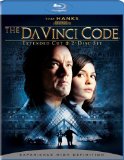| Reviews & Columns |
|
Reviews DVD TV on DVD Blu-ray 4K UHD International DVDs In Theaters Reviews by Studio Video Games Features Collector Series DVDs Easter Egg Database Interviews DVD Talk Radio Feature Articles Columns Anime Talk DVD Savant Horror DVDs The M.O.D. Squad Art House HD Talk Silent DVD
|
DVD Talk Forum |
|
|
| Resources |
|
DVD Price Search Customer Service #'s RCE Info Links |
|
Columns
|
|
|
Da Vinci Code - Extended Cut, The
Sony Pictures // PG-13 // April 28, 2009
List Price: $38.96 [Buy now and save at Amazon]
The Film:
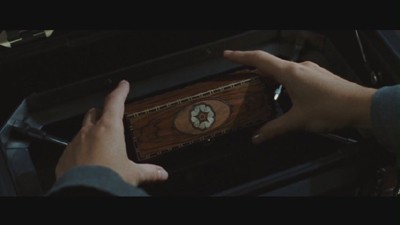 Opinions varied wildly on The Da Vinci Code during its release in 2006, from merely polite clapping at its Cannes' debut to the vile snipping from protesters and unimpressed critics. Whether they supported or bashed the film, there was one common takeaway: Ron Howard's adaptation of Dan Brown's religion-bending thriller was simply too long. Never mind the oddness of Ton Hanks' hair of Audrey Tautou's now-visible awkwardness as Sophie Neveu, the paramount point is that The Da Vinci Code's two-and-a-half hours failed to mix together tone and pacing into an event as likable as the breakneck, page-flipping novel. Though still enjoyable in this reviewer's eyes (click here for my initial thoughts on the Theatrical Cut), the stumbling blocks are blatantly obvious.
Opinions varied wildly on The Da Vinci Code during its release in 2006, from merely polite clapping at its Cannes' debut to the vile snipping from protesters and unimpressed critics. Whether they supported or bashed the film, there was one common takeaway: Ron Howard's adaptation of Dan Brown's religion-bending thriller was simply too long. Never mind the oddness of Ton Hanks' hair of Audrey Tautou's now-visible awkwardness as Sophie Neveu, the paramount point is that The Da Vinci Code's two-and-a-half hours failed to mix together tone and pacing into an event as likable as the breakneck, page-flipping novel. Though still enjoyable in this reviewer's eyes (click here for my initial thoughts on the Theatrical Cut), the stumbling blocks are blatantly obvious.
Sony's answer to the film's lackluster reaction is a little odd: to release an even longer cut on Blu-ray, the presupposed international "Extended" version of the brooding, difficult-to-enjoy thriller that claws along for nearly three hours (174 minutes, to be exact). Somehow, the added material helps, but in more indirect, discreet ways that won't change one's overall outlook on the picture itself. The Da Vinci Code's twenty-eight (28) minutes of extensions push it along by answering minor questions and concentrating on blurry elements from before, resulting in a more cohesive version of the same story.
For those unversed, The Da Vinci Code follows Robert Langdon (Hanks) and Sophie Neveu (Tautou) as they trot the globe -- first in Paris, then to London and beyond -- to solve the riddle of the Holy Grail. More specifically, they're on the run from the law in connection with the murder of the Louvre's curator, Jacques Sauniere, who is also Sophie's grandfather. Sauniere was, in actuality, killed by an albino monk named Silas (Paul Bettany), a misguided and devout Opus Dei pawn working under the power of Bishop Aringarosa (Alfred Molina). He, in turn, is following the guiding hand of a man known only as "The Teacher". As Langdon and Sophie scramble to piece together the clues behind Sauniere's killers, religious fanatics in search of the Holy Grail in order to destroy it, they begin to learn an array of "truths" behind Leonardo Da Vinci, symbolism behind the "chalice", and hypothetical rumors about Jesus Christ himself.
The Da Vinci Code, as a narrative, is a tremendously satisfying mystery with a whopper of a twist at its core, a spin on Renaissance art and Biblical theory that has sparked more than a handful of documentaries, discussions, and protests around its nature. More importantly, the time spent blitzing through the two-pages-per-chapter whodunit can best be antiquated with one word ... "fun". Director Ron Howard, along with the guidance of Dan Brown as producer, decided to give his cinematic vision a dark, almost joyless disposition that mirrors the shady recesses of his Academy Award-winning film A Beautiful Mind. His directorial style makes for an odd marriage with Brown's source material, though he still captures the essence of intrigue simmering at its core. In motion, however, it doesn't quite do justice to the source -- but he still crafts a thought-provoking and partly suspenseful flow that works, at least to a few degrees.
A large portion of its success as a motion picture hinges on Sir Iak McKellen as Leigh Teabing, a bizarre turn considering that the Lord of the Rings and Gods and Monsters actor doesn't exactly fit the character's outline in the book. Once he enters into the narrative roughly a third of the way into The Da Vinci Code, it starts to regain some of the personality and vibrancy lost in the bleak moments at the start of the film. He's the force behind the trumpeted "twist", and hearing his energy behind the delivery almost justifies the whole film. His billowing, theatrical energy almost makes up for Tom Hanks and Audrey Tautou, whom are both, out of a lack of words to describe them, merely fine as the two leads that share little to no chemistry. While Langdon and Sophie Neveu share a balanced dynamic in the book that flip-flips between father/daughter posturing and that of two potentially attracted lovers, Hanks and Tautou carry barely anything above stiff acquaintance. They both perform their roles well-enough with the right posturing and showcase the right elements that could spell out proper character portrayals, but they becomes less and less satisfying with subsequent screenings.
Viewers should bear in mind that The Da Vinci Code and all of its conceptualizations are a work of fiction, a major "what if" in the vein of thrilling storytelling that's purely out to entertain and, maybe, dish out a taste of thought to chew on afterwards. Dan Brown's book is a quick, easy, and entertaining read, one that usually hooks its readers quickly then transforms into a two-day or week long page-turning blitz -- and recommended well above the film version. Howard's film, though sporting a stiff, melancholy essence, still gathers together the rudiments that it needs in order to tell the same story, even if it's not nearly as gripping. Hours can seem like minutes when reading the book, while minutes still feel like minutes when watching its cinematic adaptation. Brown's prequel, entitled Angels and Demons, thrives on a darker, more mysterious rhythm that trumps the suspense anchored heavily on The Da Vinci Code's big reveal. After seeing Howard's direction here, it's easy to have faith that he'll bring Angels and Demons to life in a much more accurate fashion than this fumbled yet compelling thriller.
Theatrical vs. Extended:
As of late, home entertainment enthusiasts have been treated to an array of quality alternate cuts of popular movies -- including superior cuts of Kingdom of Heaven, Jet Li's Fearless, and Ridley Scott's re-re-engineered Blade Runner. The Da Vinci Code, however, isn't nearly as revolutionary as these re-imaginings, instead living up the title "Extended" as best as it can. Boosted from a hair less than two-and-a-half hours to nearly three hours in length (runtime 2:54:37), Sony gives Da Vinci Code buffs an extra 28+ minutes to digest. From beginning to end, nothing has really been changed to alter the narrative -- but it's a much more comfortable and logically understandable cut. Emphasis and pacing are the two primary elements reinvigorated in this longer version of the film, making choppy scenes that only marginally made sense in the theatrical rendition make much more sense.
As to be expected, unavoidable spoilers follow:
Small additions, such as an extension to Langdon and police captain Bezu Fache's (Jean Reno) conversation leading into the elevator in the Louvre, help make the scenes that follow them make more sense -- though we're still able to grasp a hold of the general idea in the original cut. Other extensions, like footage tacked onto the flashback scenario in which we learn about Silas' past with Aringarosa, add to character motivation and understanding. Along those same lines, we're given a montage of Silas' previous murders in grainy "flashback" vision before he chastises himself for a second time.
We're also given more material between Teabing and Langdon, revolving around Constantine in the meal scene directly before the "big reveal" -- which has remained untouched, as far as could be told. A few more extensions have also been added, like a mentioning of Sophie as a "young dog", material focusing around the danger of the park where Langdon and Sophie stop and think, and some additional emphasis on Bezu Fache's police officer assistant and the ways in which he assists in the hunt.
Then, we're also given a few lengthier add-on sequences not in the original cut, ones that steer clear of manipulating the outcome of the story. Bishop Aringarosa earns more personality through his conversations with the eldest cardinal before and after the meeting with the elder council. That entire sequence, choppy and rather nonsensical before, makes much more sense this time around when Molina begins his ranting and raving. Also, a conversation has been added between Langdon and Sophie that emphasizes Langdon's loyalty to seeing out the lineage of the Holy Grail. Furthermore, a rather stilted scene involving Sophie holding the Madonna on the Rocks hostage in the Louvre has been brought in -- which is a fun sequence, but a little awkward.
Finally, it's worth mentioning that some very, very small clips and camera tricks used to "improve" pacing and potential R-rating labeling have been reinvigorated in this cut. Here, the camera has been pulled back during the murder scenes, showcasing more gruesome images of Sauniere in the Louvre and a few bloody shots of the nun in the church. Also, extensions of running sequences, Langdon's trollop through Paris at the conclusion, and other ambient clips have been re-stitched into the film. It's here that some of my favorite small additions have been added: from a sequence where Sophie mentions the "sacred feminine" to a very slight addition of Robert placing his GPS dot next to the bar of soap in the bathroom in the Louvre, these minuscule little addendums unquestionably add a stronger sense of understandability to a rather complex, buzzing-like-a-beehive narrative.
End of revealing spoilers.
Has anything been removed? It doesn't seem like it. Hanks still delivers the ever-so-annoying "Da Vinci" about the Madonna on the Rocks, something that occurs shortly after Audrey Tautou gives a discomforting line about the "Mona Lisa" being in close proximity to them. Also, the usage of a cell phone instead of a library remains intact, something that left me bothered from the first screening. Essentially, anything that drove a movie goer nuts about the previous cut of The Da Vinci Code will still likely strike them in this Extended Cut, only with some strong additions that help counterbalance the quibbles.
Long story short -- you're getting the same Da Vinci Code, only with more breathing room, more emphasis on confusing material to help things make sense, and a few boosts in character intrigue. Bear in mind, however, that this is still THREE HOURS of The Da Vinci Code, a film that was already longer than it needed to be in the theaters. It's a stronger, more preferable cut, sure, but it's still a three-hour drudge through the same bleakness and tricky misalignment between source material and Howard's directorial eye.
The Blu-ray:
Sony has presented the Extended Cut of The Da Vinci Code in a two-disc Blu-ray set, porting over all of the special features from the initial standard-definition DVD. However, keep in mind that the Theatrical Cut is NOT on this set -- only the 174 minute Extended Cut.
Video and Audio:
Overall, The Da Vinci Code looks satisfactory in its 2.35:1 theatrical framing, appearing extremely film-like in its 1080p AVC image. However, there's a relatively noisy haze draped over the entirety of the film that lends it a softness that detracts from its potential clarity. Most of it largely stems from film grain, but it seems to work against the details against skin textures and outlines. However, color correctness in skin tones and back drops, especially with the paintings in several of the opening shots within the Louvre, look extremely strong.
Black levels receive a solid boost above the standard-definition image. The Da Vinci Code is a predominately dark film, which means that handling contrast and noise levels in dimly lit sequences is a must. It handles them to a moderate degree, still causing a slight flicker in some of the non-black shadows. No edge enhancement or noise reduction could be spotted in the image, as it wears its film stock properties on its sleeve -- as it should. Also, once the film actually does step into the light near the end of Langdon and Sophie's night of chaos, many of the problematic areas vanish into a crisp and brilliantly contrasted image. It's attractive, richly colored, and aptly dark at all the right points, even if it's not quite as sharp as expected.
Matched with English and French Dolby TrueHD tracks, The Da Vinci Code's audio treatment matches the visuals well. Dialogue gets a healthy boost above the English 5.1 legacy track, making some difficult-to-hear audio elements -- referring to Tautou's accent in particular -- a bit easier to discern. The musical accompaniment gets a nice treatment, with fluctuating crescendos holding their fluidity throughout. It's not a terribly dynamic track though due to its focus on speech, keeping a large amount of the activity at the front of the soundstage, but it'll surprise with its dynamics in a few points. A couple of ambient effects echoes to the rears, like the slamming of a metal trap gate or the dropping of a bullet casing, along with Zimmer's score and a few other sound design elements. Optional subtitles are available in English, English SDH, and French languages.
Special Features:
Picture in Picture Interactive Experience:
Integrating interview time, factoids, and behind-the-scenes footage, this feature utilizes the Javascript availabilities of Blu-ray technology to a substantial level. It uses an interface that appears in the black bars above and below the 2.35:1 image, showcasing icons at the top that enable the following functions: Interviews (microphone), Storyboards (pencil), Prop Talk (rose), B-Roll (slate), Photos (film reel), Symbols and Codes (puzzle piece), Langdon's Journey (magnifying Glass) and Location Trivia (star). Each of these flash intermittently throughout the film, several time with two and three of the icons lit up for selection. In all, the material does pretty much what it sets out to do, adding character emphasis with Hanks' interviews and script / directorial insight from Ron Howard, Dan Brown, and others. Probably my favorite part of the picture-in-picture was watching the behind-the-scenes footage that coordinates with the scene currently playing in the film.
Selective Scene Commentary with Ron Howard (38:52) :
Ron Howard's commentary remains upbeat and mildly informative, yet also solely centered on praising the achievements of his production. They also don't stay terribly "scene specific" but more centered on elaborating on the characters and situations textually. Still, once it reaches discussion revolving around the film's pivotal revelation sequence, it's nice to hear his thoughts on the whole scenario.
Along with these features, we're also given a Sneak Peek into Angels and Demons -- five minutes of footage, along with a two-minute Trailer for the film. Furthermore, this Blu-ray has been activated with BD-Live and CineChat. As of this writing, the only features available on the Sony server regarding The Da Vinci Code are an online claim for a ticket voucher to see Angels and Demons, as well as a feed that'll become active at the premiere of Angels and Demons.
Disc 2 carries over the supplements available on the second disc of the Two-Disc Special Edition DVD. Alongside those, however, we've also got a few new pieces wrangled together for this Blu-ray edition. All of these special features are available in HD MPEG-2 encodes:
From Theatrical DVD:
Originally, there was a "Play All" feature that strung together all of the aforementioned supplements, creating a fully cohesive documentary-like flow. That option has been removed, but the content still remains the same with the transitions and graphics:
- First Day on the Set with Ron Howard
- Discussion with Dan Brown
- Portrait of Robert Langdon
- Who is Sophie Neveu?
- Unusual Suspects
- Magical Places
- Close Up of Mona Lisa
- Filmmaker's Journey Parts I and II
- Codes of The Da Vinci Code
- Music of The Da Vinci Code
Each segment takes a surface glance at the particular elements. The majority of this documentary series is insightful and entertaining. I greatly enjoyed the First Day on the Set and Magical Places pieces. The opportunity to be taken through the beauty and the challenges of the locales across Paris, London, Scotland and others was exceptional. Also, The Mona Lisa portion gives very heartfelt, honest insights into the cast and crew's experiences with the painting during the Louvre shoot. Furthermore, the Codes of The Da Vinci Code portion was surprisingly entertaining. This feature illustrates the clues and symbolic visual elements that are scattered throughout the film. I also felt the three character study pieces were sufficiently explanatory on the casting decisions and motivational elements of crafting Langdon, Neveu, and the antagonists.
Book to Screen (11:06, NEW):
Director Ron Howard, author Dan Brown, and the rest of the writers and producers dive into the process of adapting the blockbuster novel to screen. It exposes Brown's desire to adapt his stories once a trilogy had been completed, along with some slick behind-the-scenes shots of the crew exploring the sites for the right vision in adapting the film's stage.
The Da Vinci Props (9:43, NEW):
Probably my favorite of the new features, this piece covers the process of bringing Dan Brown's descriptions to life via prop design. It showcases Brown's amazement with their capacity to take his illustrative capacity and bring them to tangible life in the film, as well as focusing closely on several of the props themselves -- which is interesting, especially in seeing the props outside of the film's setting.
The Da Vinci Sets (9:10, NEW):
Taking on a similar rhythm to the props featurette, this featurette showcases how director Ron Howard assembled his ideals for the set design. He and his producers, especially production designer Allen Cameron, discuss how they took storyboards and assembled them into beautiful set design. Neat elements, like cardboard mini-models and lighting rudiments, slip into the featurette in between film footage and interview time. It's also enjoyable to hear Ian McKellen discuss his involvement with a few suggestions for the set design.
Recreating Works of Art (6:03, NEW):
Covering how they replicated the Louvre and its works of art, this piece covers exactly how they incorporated the art into the set design. It's an intriguing look into a tricky situation, and how they incorporated 130+ paintings into the full shoot.
Visual Effects of The Da Vinci Code (15:03, NEW):
Ron Howard opens up his sleeves and shows us how he composed many of the visual tricks in The Da Vinci Code. Visual effects producers chime in to describe how they conceived many of the visually intriguing elements of the picture, from the flashback sequences to finagling digital imagery into tricking the audience into believing that the film actually takes place in a famous location.
Scoring The Da Vinci Code(9:44, NEW):
Branching off of the music featurette from before, we're taken in the recording location -- an echoic cathedral optimal for the proper mood in the score. Howard continues to discuss the process, along with taking us into the actual recording sessions with Hanz Zimmer. Zimmer gets his chance to talk about the project, while seeing him behind the table with the director during the process.
Finally, we've got a series of Trailers for other Sony products.
Final Thoughts:
If you didn't favor The Da Vinci Code after a first or second screening of the theatrical cut, then your mind won't really be changed by this Extended Cut on Blu-ray -- which is just that, an extension of the previous assembly that cleans up some of the semi-answered questions and adds an assortment of character moments with Tom Hanks, Audrey Tautou, and Ian McKellen. If you did enjoy The Da Vinci Code, however, then this beefier, more cohesive version will more than satisfy, along with adding a few extra tastes of the book's essence in the picture. For those coming into the film blindly, then this Blu-ray is the preferred version to watch -- a dark three-hour adaptation of a rapidly paced novel, one that falls behind the source material by quite a few steps but still captures its suspenseful essence in intermittent breaths.
Sony has really dishes out an substantial undertaking with this Blu-ray, incorporating strong digital qualities regarding the film itself with fantastic implementation of Blu-ray's Javascript Picture-in-Picture capacity. Along with that, we've also got a slate of nice supplements, both old and new, as well as a serviceable array of scene-selective commentary tracks from director Ron Howard. It's a firmly Recommended purchase for this decent adaptation of Dan Brown's culturally iconic novel.
Thomas Spurlin, Staff Reviewer -- DVDTalk Reviews | Personal Blog/Site
 Opinions varied wildly on The Da Vinci Code during its release in 2006, from merely polite clapping at its Cannes' debut to the vile snipping from protesters and unimpressed critics. Whether they supported or bashed the film, there was one common takeaway: Ron Howard's adaptation of Dan Brown's religion-bending thriller was simply too long. Never mind the oddness of Ton Hanks' hair of Audrey Tautou's now-visible awkwardness as Sophie Neveu, the paramount point is that The Da Vinci Code's two-and-a-half hours failed to mix together tone and pacing into an event as likable as the breakneck, page-flipping novel. Though still enjoyable in this reviewer's eyes (click here for my initial thoughts on the Theatrical Cut), the stumbling blocks are blatantly obvious.
Opinions varied wildly on The Da Vinci Code during its release in 2006, from merely polite clapping at its Cannes' debut to the vile snipping from protesters and unimpressed critics. Whether they supported or bashed the film, there was one common takeaway: Ron Howard's adaptation of Dan Brown's religion-bending thriller was simply too long. Never mind the oddness of Ton Hanks' hair of Audrey Tautou's now-visible awkwardness as Sophie Neveu, the paramount point is that The Da Vinci Code's two-and-a-half hours failed to mix together tone and pacing into an event as likable as the breakneck, page-flipping novel. Though still enjoyable in this reviewer's eyes (click here for my initial thoughts on the Theatrical Cut), the stumbling blocks are blatantly obvious. Sony's answer to the film's lackluster reaction is a little odd: to release an even longer cut on Blu-ray, the presupposed international "Extended" version of the brooding, difficult-to-enjoy thriller that claws along for nearly three hours (174 minutes, to be exact). Somehow, the added material helps, but in more indirect, discreet ways that won't change one's overall outlook on the picture itself. The Da Vinci Code's twenty-eight (28) minutes of extensions push it along by answering minor questions and concentrating on blurry elements from before, resulting in a more cohesive version of the same story.
For those unversed, The Da Vinci Code follows Robert Langdon (Hanks) and Sophie Neveu (Tautou) as they trot the globe -- first in Paris, then to London and beyond -- to solve the riddle of the Holy Grail. More specifically, they're on the run from the law in connection with the murder of the Louvre's curator, Jacques Sauniere, who is also Sophie's grandfather. Sauniere was, in actuality, killed by an albino monk named Silas (Paul Bettany), a misguided and devout Opus Dei pawn working under the power of Bishop Aringarosa (Alfred Molina). He, in turn, is following the guiding hand of a man known only as "The Teacher". As Langdon and Sophie scramble to piece together the clues behind Sauniere's killers, religious fanatics in search of the Holy Grail in order to destroy it, they begin to learn an array of "truths" behind Leonardo Da Vinci, symbolism behind the "chalice", and hypothetical rumors about Jesus Christ himself.
The Da Vinci Code, as a narrative, is a tremendously satisfying mystery with a whopper of a twist at its core, a spin on Renaissance art and Biblical theory that has sparked more than a handful of documentaries, discussions, and protests around its nature. More importantly, the time spent blitzing through the two-pages-per-chapter whodunit can best be antiquated with one word ... "fun". Director Ron Howard, along with the guidance of Dan Brown as producer, decided to give his cinematic vision a dark, almost joyless disposition that mirrors the shady recesses of his Academy Award-winning film A Beautiful Mind. His directorial style makes for an odd marriage with Brown's source material, though he still captures the essence of intrigue simmering at its core. In motion, however, it doesn't quite do justice to the source -- but he still crafts a thought-provoking and partly suspenseful flow that works, at least to a few degrees.
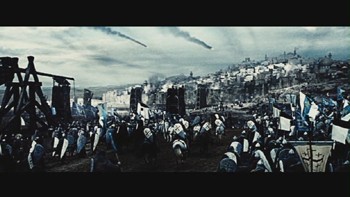 | 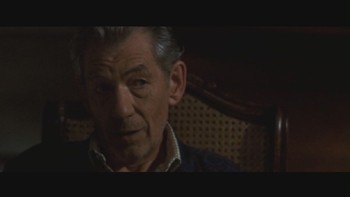 |
A large portion of its success as a motion picture hinges on Sir Iak McKellen as Leigh Teabing, a bizarre turn considering that the Lord of the Rings and Gods and Monsters actor doesn't exactly fit the character's outline in the book. Once he enters into the narrative roughly a third of the way into The Da Vinci Code, it starts to regain some of the personality and vibrancy lost in the bleak moments at the start of the film. He's the force behind the trumpeted "twist", and hearing his energy behind the delivery almost justifies the whole film. His billowing, theatrical energy almost makes up for Tom Hanks and Audrey Tautou, whom are both, out of a lack of words to describe them, merely fine as the two leads that share little to no chemistry. While Langdon and Sophie Neveu share a balanced dynamic in the book that flip-flips between father/daughter posturing and that of two potentially attracted lovers, Hanks and Tautou carry barely anything above stiff acquaintance. They both perform their roles well-enough with the right posturing and showcase the right elements that could spell out proper character portrayals, but they becomes less and less satisfying with subsequent screenings.
Viewers should bear in mind that The Da Vinci Code and all of its conceptualizations are a work of fiction, a major "what if" in the vein of thrilling storytelling that's purely out to entertain and, maybe, dish out a taste of thought to chew on afterwards. Dan Brown's book is a quick, easy, and entertaining read, one that usually hooks its readers quickly then transforms into a two-day or week long page-turning blitz -- and recommended well above the film version. Howard's film, though sporting a stiff, melancholy essence, still gathers together the rudiments that it needs in order to tell the same story, even if it's not nearly as gripping. Hours can seem like minutes when reading the book, while minutes still feel like minutes when watching its cinematic adaptation. Brown's prequel, entitled Angels and Demons, thrives on a darker, more mysterious rhythm that trumps the suspense anchored heavily on The Da Vinci Code's big reveal. After seeing Howard's direction here, it's easy to have faith that he'll bring Angels and Demons to life in a much more accurate fashion than this fumbled yet compelling thriller.
Theatrical vs. Extended:
As of late, home entertainment enthusiasts have been treated to an array of quality alternate cuts of popular movies -- including superior cuts of Kingdom of Heaven, Jet Li's Fearless, and Ridley Scott's re-re-engineered Blade Runner. The Da Vinci Code, however, isn't nearly as revolutionary as these re-imaginings, instead living up the title "Extended" as best as it can. Boosted from a hair less than two-and-a-half hours to nearly three hours in length (runtime 2:54:37), Sony gives Da Vinci Code buffs an extra 28+ minutes to digest. From beginning to end, nothing has really been changed to alter the narrative -- but it's a much more comfortable and logically understandable cut. Emphasis and pacing are the two primary elements reinvigorated in this longer version of the film, making choppy scenes that only marginally made sense in the theatrical rendition make much more sense.
As to be expected, unavoidable spoilers follow:
Small additions, such as an extension to Langdon and police captain Bezu Fache's (Jean Reno) conversation leading into the elevator in the Louvre, help make the scenes that follow them make more sense -- though we're still able to grasp a hold of the general idea in the original cut. Other extensions, like footage tacked onto the flashback scenario in which we learn about Silas' past with Aringarosa, add to character motivation and understanding. Along those same lines, we're given a montage of Silas' previous murders in grainy "flashback" vision before he chastises himself for a second time.
We're also given more material between Teabing and Langdon, revolving around Constantine in the meal scene directly before the "big reveal" -- which has remained untouched, as far as could be told. A few more extensions have also been added, like a mentioning of Sophie as a "young dog", material focusing around the danger of the park where Langdon and Sophie stop and think, and some additional emphasis on Bezu Fache's police officer assistant and the ways in which he assists in the hunt.
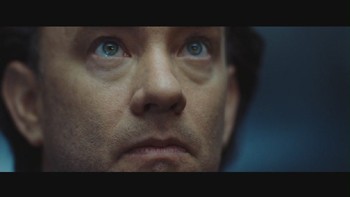 | 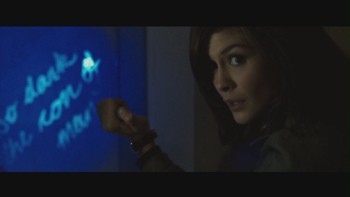 |
Then, we're also given a few lengthier add-on sequences not in the original cut, ones that steer clear of manipulating the outcome of the story. Bishop Aringarosa earns more personality through his conversations with the eldest cardinal before and after the meeting with the elder council. That entire sequence, choppy and rather nonsensical before, makes much more sense this time around when Molina begins his ranting and raving. Also, a conversation has been added between Langdon and Sophie that emphasizes Langdon's loyalty to seeing out the lineage of the Holy Grail. Furthermore, a rather stilted scene involving Sophie holding the Madonna on the Rocks hostage in the Louvre has been brought in -- which is a fun sequence, but a little awkward.
Finally, it's worth mentioning that some very, very small clips and camera tricks used to "improve" pacing and potential R-rating labeling have been reinvigorated in this cut. Here, the camera has been pulled back during the murder scenes, showcasing more gruesome images of Sauniere in the Louvre and a few bloody shots of the nun in the church. Also, extensions of running sequences, Langdon's trollop through Paris at the conclusion, and other ambient clips have been re-stitched into the film. It's here that some of my favorite small additions have been added: from a sequence where Sophie mentions the "sacred feminine" to a very slight addition of Robert placing his GPS dot next to the bar of soap in the bathroom in the Louvre, these minuscule little addendums unquestionably add a stronger sense of understandability to a rather complex, buzzing-like-a-beehive narrative.
End of revealing spoilers.
Has anything been removed? It doesn't seem like it. Hanks still delivers the ever-so-annoying "Da Vinci" about the Madonna on the Rocks, something that occurs shortly after Audrey Tautou gives a discomforting line about the "Mona Lisa" being in close proximity to them. Also, the usage of a cell phone instead of a library remains intact, something that left me bothered from the first screening. Essentially, anything that drove a movie goer nuts about the previous cut of The Da Vinci Code will still likely strike them in this Extended Cut, only with some strong additions that help counterbalance the quibbles.
Long story short -- you're getting the same Da Vinci Code, only with more breathing room, more emphasis on confusing material to help things make sense, and a few boosts in character intrigue. Bear in mind, however, that this is still THREE HOURS of The Da Vinci Code, a film that was already longer than it needed to be in the theaters. It's a stronger, more preferable cut, sure, but it's still a three-hour drudge through the same bleakness and tricky misalignment between source material and Howard's directorial eye.
The Blu-ray:
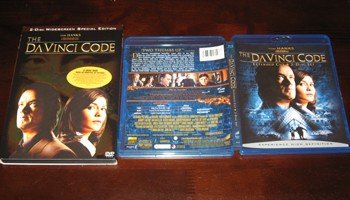 | 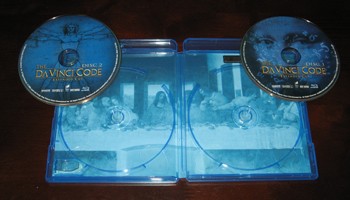 |
Sony has presented the Extended Cut of The Da Vinci Code in a two-disc Blu-ray set, porting over all of the special features from the initial standard-definition DVD. However, keep in mind that the Theatrical Cut is NOT on this set -- only the 174 minute Extended Cut.
Video and Audio:
Overall, The Da Vinci Code looks satisfactory in its 2.35:1 theatrical framing, appearing extremely film-like in its 1080p AVC image. However, there's a relatively noisy haze draped over the entirety of the film that lends it a softness that detracts from its potential clarity. Most of it largely stems from film grain, but it seems to work against the details against skin textures and outlines. However, color correctness in skin tones and back drops, especially with the paintings in several of the opening shots within the Louvre, look extremely strong.
Black levels receive a solid boost above the standard-definition image. The Da Vinci Code is a predominately dark film, which means that handling contrast and noise levels in dimly lit sequences is a must. It handles them to a moderate degree, still causing a slight flicker in some of the non-black shadows. No edge enhancement or noise reduction could be spotted in the image, as it wears its film stock properties on its sleeve -- as it should. Also, once the film actually does step into the light near the end of Langdon and Sophie's night of chaos, many of the problematic areas vanish into a crisp and brilliantly contrasted image. It's attractive, richly colored, and aptly dark at all the right points, even if it's not quite as sharp as expected.
Matched with English and French Dolby TrueHD tracks, The Da Vinci Code's audio treatment matches the visuals well. Dialogue gets a healthy boost above the English 5.1 legacy track, making some difficult-to-hear audio elements -- referring to Tautou's accent in particular -- a bit easier to discern. The musical accompaniment gets a nice treatment, with fluctuating crescendos holding their fluidity throughout. It's not a terribly dynamic track though due to its focus on speech, keeping a large amount of the activity at the front of the soundstage, but it'll surprise with its dynamics in a few points. A couple of ambient effects echoes to the rears, like the slamming of a metal trap gate or the dropping of a bullet casing, along with Zimmer's score and a few other sound design elements. Optional subtitles are available in English, English SDH, and French languages.
Special Features:
Picture in Picture Interactive Experience:
Integrating interview time, factoids, and behind-the-scenes footage, this feature utilizes the Javascript availabilities of Blu-ray technology to a substantial level. It uses an interface that appears in the black bars above and below the 2.35:1 image, showcasing icons at the top that enable the following functions: Interviews (microphone), Storyboards (pencil), Prop Talk (rose), B-Roll (slate), Photos (film reel), Symbols and Codes (puzzle piece), Langdon's Journey (magnifying Glass) and Location Trivia (star). Each of these flash intermittently throughout the film, several time with two and three of the icons lit up for selection. In all, the material does pretty much what it sets out to do, adding character emphasis with Hanks' interviews and script / directorial insight from Ron Howard, Dan Brown, and others. Probably my favorite part of the picture-in-picture was watching the behind-the-scenes footage that coordinates with the scene currently playing in the film.
Selective Scene Commentary with Ron Howard (38:52) :
Ron Howard's commentary remains upbeat and mildly informative, yet also solely centered on praising the achievements of his production. They also don't stay terribly "scene specific" but more centered on elaborating on the characters and situations textually. Still, once it reaches discussion revolving around the film's pivotal revelation sequence, it's nice to hear his thoughts on the whole scenario.
Along with these features, we're also given a Sneak Peek into Angels and Demons -- five minutes of footage, along with a two-minute Trailer for the film. Furthermore, this Blu-ray has been activated with BD-Live and CineChat. As of this writing, the only features available on the Sony server regarding The Da Vinci Code are an online claim for a ticket voucher to see Angels and Demons, as well as a feed that'll become active at the premiere of Angels and Demons.
Disc 2 carries over the supplements available on the second disc of the Two-Disc Special Edition DVD. Alongside those, however, we've also got a few new pieces wrangled together for this Blu-ray edition. All of these special features are available in HD MPEG-2 encodes:
From Theatrical DVD:
Originally, there was a "Play All" feature that strung together all of the aforementioned supplements, creating a fully cohesive documentary-like flow. That option has been removed, but the content still remains the same with the transitions and graphics:
- First Day on the Set with Ron Howard
- Discussion with Dan Brown
- Portrait of Robert Langdon
- Who is Sophie Neveu?
- Unusual Suspects
- Magical Places
- Close Up of Mona Lisa
- Filmmaker's Journey Parts I and II
- Codes of The Da Vinci Code
- Music of The Da Vinci Code
Each segment takes a surface glance at the particular elements. The majority of this documentary series is insightful and entertaining. I greatly enjoyed the First Day on the Set and Magical Places pieces. The opportunity to be taken through the beauty and the challenges of the locales across Paris, London, Scotland and others was exceptional. Also, The Mona Lisa portion gives very heartfelt, honest insights into the cast and crew's experiences with the painting during the Louvre shoot. Furthermore, the Codes of The Da Vinci Code portion was surprisingly entertaining. This feature illustrates the clues and symbolic visual elements that are scattered throughout the film. I also felt the three character study pieces were sufficiently explanatory on the casting decisions and motivational elements of crafting Langdon, Neveu, and the antagonists.
Book to Screen (11:06, NEW):
Director Ron Howard, author Dan Brown, and the rest of the writers and producers dive into the process of adapting the blockbuster novel to screen. It exposes Brown's desire to adapt his stories once a trilogy had been completed, along with some slick behind-the-scenes shots of the crew exploring the sites for the right vision in adapting the film's stage.
The Da Vinci Props (9:43, NEW):
Probably my favorite of the new features, this piece covers the process of bringing Dan Brown's descriptions to life via prop design. It showcases Brown's amazement with their capacity to take his illustrative capacity and bring them to tangible life in the film, as well as focusing closely on several of the props themselves -- which is interesting, especially in seeing the props outside of the film's setting.
The Da Vinci Sets (9:10, NEW):
Taking on a similar rhythm to the props featurette, this featurette showcases how director Ron Howard assembled his ideals for the set design. He and his producers, especially production designer Allen Cameron, discuss how they took storyboards and assembled them into beautiful set design. Neat elements, like cardboard mini-models and lighting rudiments, slip into the featurette in between film footage and interview time. It's also enjoyable to hear Ian McKellen discuss his involvement with a few suggestions for the set design.
Recreating Works of Art (6:03, NEW):
Covering how they replicated the Louvre and its works of art, this piece covers exactly how they incorporated the art into the set design. It's an intriguing look into a tricky situation, and how they incorporated 130+ paintings into the full shoot.
Visual Effects of The Da Vinci Code (15:03, NEW):
Ron Howard opens up his sleeves and shows us how he composed many of the visual tricks in The Da Vinci Code. Visual effects producers chime in to describe how they conceived many of the visually intriguing elements of the picture, from the flashback sequences to finagling digital imagery into tricking the audience into believing that the film actually takes place in a famous location.
Scoring The Da Vinci Code(9:44, NEW):
Branching off of the music featurette from before, we're taken in the recording location -- an echoic cathedral optimal for the proper mood in the score. Howard continues to discuss the process, along with taking us into the actual recording sessions with Hanz Zimmer. Zimmer gets his chance to talk about the project, while seeing him behind the table with the director during the process.
Finally, we've got a series of Trailers for other Sony products.
Final Thoughts:
If you didn't favor The Da Vinci Code after a first or second screening of the theatrical cut, then your mind won't really be changed by this Extended Cut on Blu-ray -- which is just that, an extension of the previous assembly that cleans up some of the semi-answered questions and adds an assortment of character moments with Tom Hanks, Audrey Tautou, and Ian McKellen. If you did enjoy The Da Vinci Code, however, then this beefier, more cohesive version will more than satisfy, along with adding a few extra tastes of the book's essence in the picture. For those coming into the film blindly, then this Blu-ray is the preferred version to watch -- a dark three-hour adaptation of a rapidly paced novel, one that falls behind the source material by quite a few steps but still captures its suspenseful essence in intermittent breaths.
Sony has really dishes out an substantial undertaking with this Blu-ray, incorporating strong digital qualities regarding the film itself with fantastic implementation of Blu-ray's Javascript Picture-in-Picture capacity. Along with that, we've also got a slate of nice supplements, both old and new, as well as a serviceable array of scene-selective commentary tracks from director Ron Howard. It's a firmly Recommended purchase for this decent adaptation of Dan Brown's culturally iconic novel.
|
| Popular Reviews |
| Sponsored Links |
|
|
| Sponsored Links |
|
|
| Release List | Reviews | Shop | Newsletter | Forum | DVD Giveaways | Blu-Ray | Advertise |
|
Copyright 2024 DVDTalk.com All Rights Reserved. Legal Info, Privacy Policy, Terms of Use,
Manage Preferences,
Your Privacy Choices | |||||||









